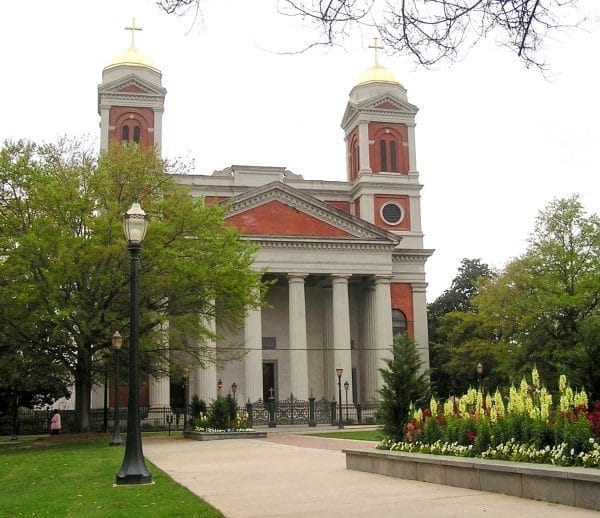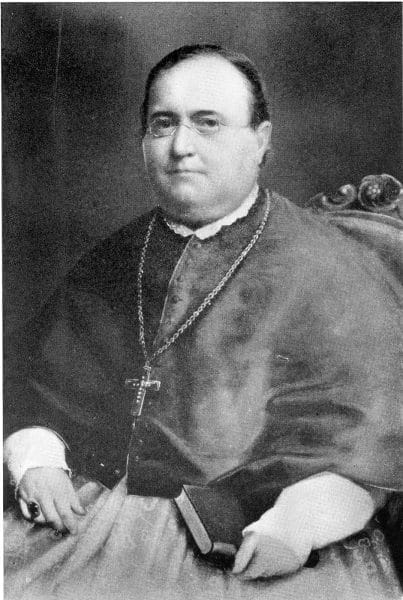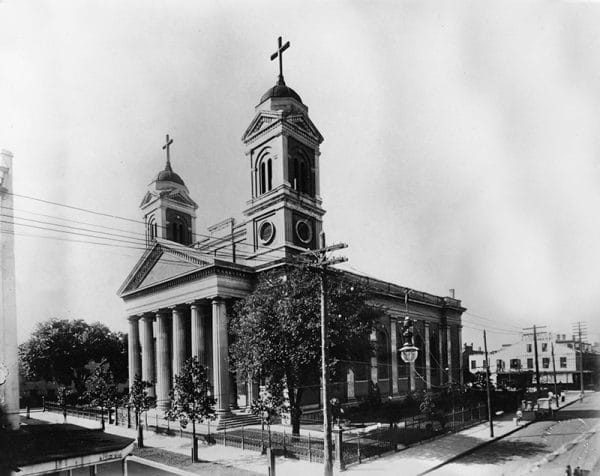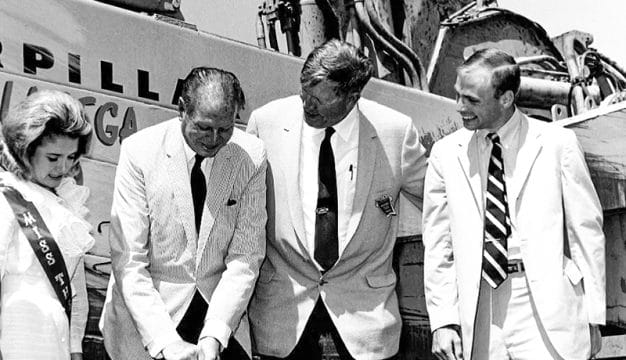Cathedral Basilica of the Immaculate Conception
The Cathedral Basilica of the Immaculate Conception in Mobile has been the focal point of Catholic worship, community, education, and evangelization since its completion in 1850. The name honors Mary, the mother of Jesus, and the building is listed on the National Register of Historic Places. Mobile has been the center of Alabama’s Catholic life since the first decades of the Colonial Era, when French Catholics first settled the region.
 Cathedral Basilica of the Immaculate Conception
Several churches preceded construction of the present cathedral, including the 1793 structure on the corner of present-day Royal and Conti Streets. When this Spanish-era church burned down in 1827, it was replaced by a wooden church and then a small brick church on the south side of Conti Street. In 1825, the Vicariate Apostolic of Alabama and the Floridas (the term used to describe the ecclesiastical jurisdiction of the region) was established, with Father Michael Portier, a French-born priest serving in New Orleans, being installed to head the vast territory. When the Diocese of Mobile was established on May 15, 1829, Portier was named the founding bishop, with the small brick church as his initial cathedral (a church headed by a bishop). The original diocese included all of Alabama and Florida.
Cathedral Basilica of the Immaculate Conception
Several churches preceded construction of the present cathedral, including the 1793 structure on the corner of present-day Royal and Conti Streets. When this Spanish-era church burned down in 1827, it was replaced by a wooden church and then a small brick church on the south side of Conti Street. In 1825, the Vicariate Apostolic of Alabama and the Floridas (the term used to describe the ecclesiastical jurisdiction of the region) was established, with Father Michael Portier, a French-born priest serving in New Orleans, being installed to head the vast territory. When the Diocese of Mobile was established on May 15, 1829, Portier was named the founding bishop, with the small brick church as his initial cathedral (a church headed by a bishop). The original diocese included all of Alabama and Florida.
 Michael Portier
Bishop Portier recognized the need for a larger, more solid structure that would better provide for the area’s Catholics, serve as the diocesan center of worship and mission outreach, and be a source of pride for Catholics in their faith. Local Catholics, with support from non-Catholics, raised funds for the new edifice, and additional financial help was secured from a branch of the Society for the Propagation of the Faith in France.
Michael Portier
Bishop Portier recognized the need for a larger, more solid structure that would better provide for the area’s Catholics, serve as the diocesan center of worship and mission outreach, and be a source of pride for Catholics in their faith. Local Catholics, with support from non-Catholics, raised funds for the new edifice, and additional financial help was secured from a branch of the Society for the Propagation of the Faith in France.
On November 29, 1835, the cornerstone for the cathedral was laid and blessed in the square bounded by Claiborne, Conti, Franklin and Dauphin Streets. Former seminarian Claude Beroujon was hired as architect for the new cathedral, having previously designed the first building constructed at Spring Hill College (1831) and the Visitation Convent (1833; now the Visitation Monastery). The foundations of the 162-by-90-foot structure were in place by 1837, but the economic crisis known as the Panic of 1837 and a yellow fever epidemic in 1839 delayed progress. By the mid-1840s, the economy had improved and construction resumed, supported in part by generous contributions from the people of Mobile. By late 1845, the brickwork was finished, but financial concerns delayed the roof’s completion.
By 1850, Mobile’s Catholic population was estimated at about 5,000. In addition to the cathedral, Catholics worshiped at St. Francis de Sales Chapel at Visitation Convent, St. Vincent de Paul Parish, and St. John Nepomucene Chapel served by the Jesuits at Spring Hill College.
The impressive structure, dedicated as the Cathedral of the Immaculate Conception on December 8, 1850, was embraced as a source of civic pride by many of the city’s citizens, Catholic and non-Catholic alike. A rector, appointed by the bishop, serves as the immediate administrator, usually assisted by one or two other priests who also served outlying missions during the nineteenth and early twentieth centuries.
The cathedral structure is of Roman design. The brick foundation of the church’s main body has walls ten feet thick and reverse brick arches beneath all exterior walls and beneath the double row of columns in the interior. In the church’s main body, two rows of Doric columns support the ceiling and divide the interior space into three naves with barrel-vaulted ceilings.
The two side ceiling vaults presently have paintings of North American saints. The center vault ceiling bears gold-leaf fleurs-de-lis and shamrocks symbolizing the French and Irish cultural heritage of the diocese. The floor of the main aisle is Italian marble bearing water-engraved and brass-inlaid coats-of-arms of all of Mobile’s bishops. The sanctuary originally included an altar of Alabama marble, but it was replaced with an Italian marble altar shortly after 1927. The apse is a hemispherical semi-dome. In the rear of the church, a choir loft houses the Wicks organ with more than 3,000 pipes, installed in 1957 and restored in 2000.
 Cathedral of the Immaculate Conception, ca. 1930
The exterior front façade has three sets of doors, each of which opens onto one of the three aisles, and a 20-foot-square tower on either side with a 60-foot portico between. The towers and the portico, with its ten fluted Doric columns, were added as funds became available. The portico was added during the tenure of Bishop John Quinlan (1859-1883), who is buried beneath it. Sometime after 1890, during the tenure of Bishop Jeremiah O’Sullivan (1885-1896), the towers were completed. Bishop Edward P. Allen (1897-1926) completed the installation of the stained glass windows, designed and built by the Franz Mayer Company of Munich, Germany; the last window was installed in 1910. The 12 main windows portray New Testament themes highlighting Mary’s role in the life of Jesus and the life of the Church.
Cathedral of the Immaculate Conception, ca. 1930
The exterior front façade has three sets of doors, each of which opens onto one of the three aisles, and a 20-foot-square tower on either side with a 60-foot portico between. The towers and the portico, with its ten fluted Doric columns, were added as funds became available. The portico was added during the tenure of Bishop John Quinlan (1859-1883), who is buried beneath it. Sometime after 1890, during the tenure of Bishop Jeremiah O’Sullivan (1885-1896), the towers were completed. Bishop Edward P. Allen (1897-1926) completed the installation of the stained glass windows, designed and built by the Franz Mayer Company of Munich, Germany; the last window was installed in 1910. The 12 main windows portray New Testament themes highlighting Mary’s role in the life of Jesus and the life of the Church.
The cathedral has undergone periodic enhancements and repairs. In 1865, the explosion of a magazine in the harbor area of Mobile 14 blocks from the cathedral blew out all the plain glass windows on the north wall (before the stained glass had been installed), and they had to be repaired. In the 1870s, a cast-iron fence was added. The bell, produced by the McShane Bell Foundry in Baltimore, Maryland, was consecrated on December 27, 1876. The bell, originally in the church nave, was later moved to the north tower.
On March 19, 1954, a large fire caused the floor in the sanctuary to collapse, and the basement was flooded during efforts to extinguish the fire. There was also extensive smoke damage, and a major restoration was required. The renovated sanctuary included a bronze canopy supported by four marble columns over the altar.
In 1962, Pope John XXIII designated the Cathedral of the Immaculate Conception as a Minor Basilica. Such designations are awarded to selected Catholic churches because of their antiquity or their historical, cultural, or artistic importance and significance as a place of worship. After receiving this designation, the cathedral was permitted to display two symbols of the status: an umbrellino, a small silk umbrella mounted on a wooden frame and covered with the papal colors of alternating red and yellow, and a small bell known as a tinabellum, a replica of the bell used in Rome’s major basilicas to announce the pope’s arrival.
 Bishop Thomas J. Toolen
In 1964, during Bishop Thomas J. Toolen’s tenure (1927-1969), the crypt chapel below the main church was completed; the tombs of all the bishops except John Quinlan (under the Portico) and John May (St. Louis) are located in the chapel. The sanctuary was again modified in 1971 in accordance with the liturgical reforms of Vatican Council II, which promoted more lay participation and replaced Latin with the vernacular for most services.
Bishop Thomas J. Toolen
In 1964, during Bishop Thomas J. Toolen’s tenure (1927-1969), the crypt chapel below the main church was completed; the tombs of all the bishops except John Quinlan (under the Portico) and John May (St. Louis) are located in the chapel. The sanctuary was again modified in 1971 in accordance with the liturgical reforms of Vatican Council II, which promoted more lay participation and replaced Latin with the vernacular for most services.
Since its early days, the Diocese of Mobile has owned a large section of the block directly opposite the cathedral’s entrance. In the late 1970s, Bishop John May (1969-1980) had the buildings that were there demolished in order to build a park. The city of Mobile partnered with the diocese to develop the entire block as a park, now owned by the City of Mobile and known as Cathedral Square. It is a venue for many public events, including special archdiocesan events several times during the year, and a popular place for Mobilians seeking quiet.
In 1980, Mobile became an Archdiocese with its province encompassing the states of Alabama and Mississippi, including the Dioceses of Birmingham, Jackson, and Biloxi, with the Cathedral Basilica of the Immaculate Conception as the archbishop’s church. Oscar H. Lipscomb, a Mobile native, was named the first archbishop (1980-2008). Archbishop Thomas J. Rodi, formerly the Bishop of Biloxi, became Mobile’s archbishop in 2008, with the Cathedral Basilica of the Immaculate Conception as his principal church.
On December 8, 2004, the Cathedral Basilica of the Immaculate Conception celebrated the tercentennial of the establishment of the Catholic Church in Mobile. This day also marked the completion of the three-year Cathedral Restoration Project, which included an exterior stabilization and restoration, roof repair, and a restored interior ceiling, side aisles, and a new Carrera marble floor.
The sacramental books of the present cathedral and its predecessors bear witness to the great ethnic diversity of the parish community, including the Native Americans, Europeans, Africans, European Colonists, and African Americans of the colonial period, the large Irish and German immigrant population of the mid-nineteenth century, service men and women, and industrial workers from throughout the United States during World War II and its aftermath, and the Hispanic and Asian immigrants more recently.
The parish’s influence has always reached beyond the cathedral itself, including early schools for both boys and girls. These institutions closed as Mobile’s population moved out of the downtown area and the diocese opened schools that were closer to the new centers of population. The cathedral parish has also supported orphanages, associations to help the poor, the sick, the elderly, and the needy, and efforts to provide financial assistance in times of natural disasters and special need.
The Cathedral Basilica of the Immaculate Conception is a popular church for weddings of Catholics from all over Mobile. It offers a concert venue for Mobile’s Musica Sacra Choir and Orchestra and Mobile’s Singing Children. The cathedral is an active participant in historic Mobile events, with self-guided tours or docent-led group tours by request and in conjunction with the nearby home of the first bishop of Mobile, the Portier House.
The main function of the Cathedral is, as it has been since its dedication, to provide for the spiritual needs of the downtown Mobile area. It offers daily Mass and the opportunity for confession and is open to all during the day for private prayer.



